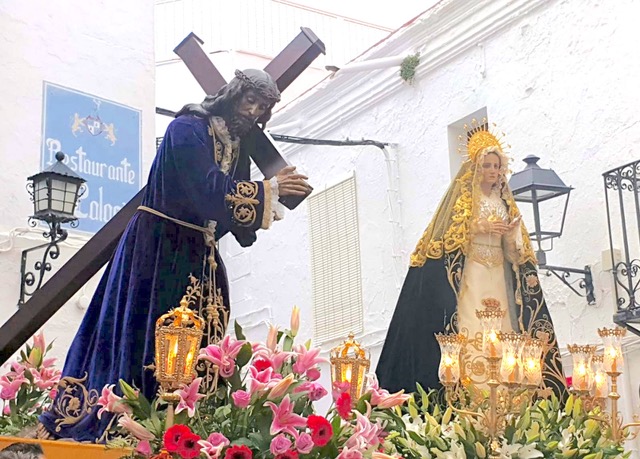Mojácar, like so many other Spanish towns, is experiencing the strangest Easter ever. This time of year is always looked forward to for all the religious events, families getting together and the bustle of visitors. However, this year everyone will celebrate at home, without being able to attend the religious services that for decades have marked the Christian commemoration of the Passion of Christ.
In Mojácar there are no official diocese religious Brotherhoods, although there are the Nazarene and Virgen of the Sorrows members who constantly maintain the images and their ornate floats ready for the processions.
The four processions that would normally pass through the streets of Mojácar at Easter are the Virgin of the Sorrows, the Nazarene, the Holy Burial and the Risen Christ.
Mojácar has always held a strong Easter tradition since before the Spanish Civil War, with the entire town participating and attending the church with its spectacular wooden altarpiece, choir stall and wonderful carved images by Salcillo. Additionally, the passion of Christ was dramatized through processions and biblical representations with characters in beautiful robes.
The building of Mojácar’s Santa María Church was started by master builder, Sebastián Segura, in the late sixteenth century on the remains of an old mosque and, it also served as a refuge against the numerous pirate attacks from along the Barbary coast.
It was the only one in the area to be burned down during the Civil War, destroying everything, including the religious images and civil documents. This grand Church and its old tower were, however, almost completely restored by the end of the 20th century, making it one of the few examples this type of architecture in the province.
Following the conflicts, little by little, the traditions were revived, along with the newly carved image of the Virgin of the Sorrows, which was acquired in the 1940s from a Venetian School in the style of that time, although the figure’s Easter robes were evocative of the Virgin by Salcillo.
The image of the Nazarene, also a magnificent carving, arrived by train to Zurgena and was then transported to Mojácar, to the admiration of everyone in the town.
Between 1981 and 1982, the Church’s High Altar area was decorated with a beautifully executed painting by the German painter Michael Sucker, who lived in Mojácar for nine years. It is possibly the most original ecclesiastical decoration in Spain, one in which the artist successfully captured the atmosphere, light and the well-known Indalo of Mojácar.
Presiding over the main altar is his figure of Jesus, dressed in white, with an arch like a rainbow simulating the silhouette of Mojácar’s Indalo symbol extending from his open palms.
During Holy Week, Mojácar’s streets are traditionally the scene of colourful processions as the elaborate trono floats, made especially for the narrow, winding streets of Mojácar, are carried through the town. With the aroma of incense, candles and flowers, the carved images are paraded, with the faithful followers behind, to the sounds of sacred music played by the Town Band.
A dramatic tradition that has seen a revival is the procession of El Encuentro, which features the images and floats of both the Virgen in her black cloak and her son, the Nazarene, who both leave the Church and take their different routes throughout the old town in silence, accompanied by the faithful in candlelight.
The Plaza del Caño is the meeting point where the Virgin awaits, before those carrying the Nazarene dramatically make “three falls” to display devotion before this Mother.





